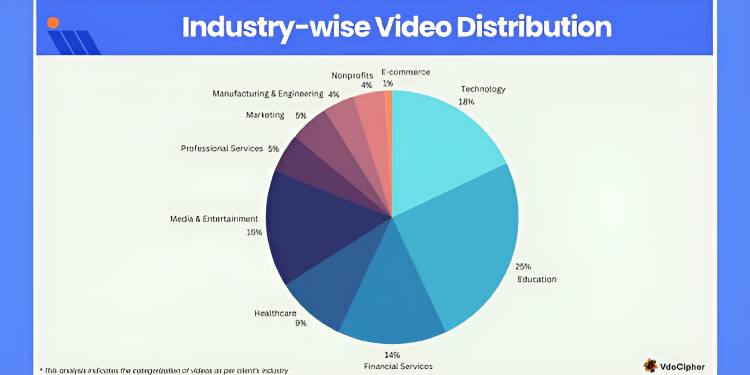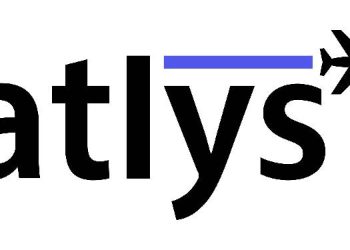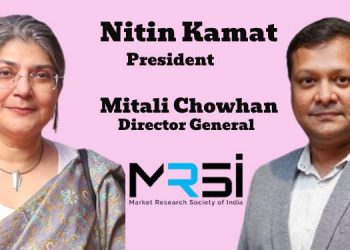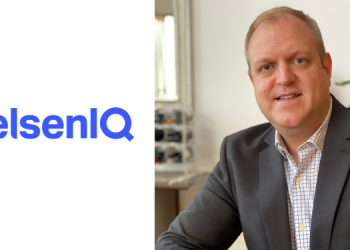India: VdoCipher, a leading provider of secure video hosting solutions, has unveiled its latest analysis of video content trends across various industries, shedding light on the rapidly evolving landscape of digital video consumption.
Siddhant Jain, CEO & Co-Founder of VdoCipher, stated, “Our findings underline the growing prominence of education and technology in the digital video space, while also highlighting evolving trends in viewer preferences and content engagement. These insights are critical for creators and organizations aiming to optimize their strategies in this dynamic landscape.”
Key Highlights from the Study:
1. Industry-Wise Video Distribution
The study reveals that Education leads the charge in video content distribution, accounting for 25%, followed by Technology at 18%, and Media and Entertainment at 15%. Financial Services make up 14%, while Healthcare represents 9%. Other industries such as Professional Services and Marketing each hold 5%, with Manufacturing and Engineering, Nonprofits, and E-commerce contributing 4%, 4%, and 1%, respectively. These findings underscore the central role of educational and technological content among VdoCipher’s clients.
2. Academic Content Preferences
Competitive Exam Test Preparation leads the charge in academic content consumption at 40%, reflecting a strong demand for preparatory materials. Programming and Data Science follow at 20%, emphasizing the growing importance of technological skill acquisition. Skill-Based (Non-Programming) Education, Higher Education, and K-12 content each hold 10%, showcasing balanced engagement across vocational training, advanced studies, and foundational learning. Language Learning and Continuing Education represent niche areas of growth, each accounting for 5%.
3. Trends in Skill-Based Education
Trading Courses top the skill-based education category with 20%, underscoring the increasing interest in financial markets. Coding/Programming and Graphic Design each hold 15%, followed by Finance and Investment courses, highlighting demand for both technical and creative skills. Platform Development stands at 10%, with Data Science and AI at 8%, demonstrating a surge in demand for analytics and machine learning expertise. Music and Sound Production (7%), Cybersecurity Training (5%), and Real Estate Education (5%) are also growing in popularity among specific professional skill sets.
4. Median Length of Video Content
The analysis reveals that Arts/Music/Media/Entertainment videos have the longest median length (50–60 minutes), reflecting immersive content experiences. IT/Programming and Spirituality videos follow closely at 40–50 minutes, offering more detailed exploration. Finance/Investment and Education videos average 30–40 minutes, balancing depth with viewer engagement. Engineering and Fitness content are more concise, averaging 10–20 minutes, while Business videos are the shortest, typically ranging from 5 to 15 minutes for quick consumption.
5. Average Viewership Percentage
Higher Education, Arts/Music/Media/Entertainment, and Spirituality content lead the pack in average viewership rates, each exceeding 80%. Finance/Trading/Investment sees over 70% engagement, while Vocational Training content exceeds 60%. K-12 Education secures steady participation with 50% viewership, while Test Preparation and Fitness content maintain dedicated audiences with viewership rates above 40%.
6. Individual Creators vs. Organizations
The study highlights a significant difference in individual versus organizational content creators across industries. Nonprofits stand out with 75% of content created by individuals, while Technology follows with 40%. Education has 28%, and Healthcare sees 26% individual participation. Media and Entertainment (22%) and Marketing (20%) also feature individual creators, while Financial Services (14%) and Professional Services (16%) are more organization-driven.
The data was compiled through customer inputs during the onboarding process, user sign-up data, and aggregated analytics reflecting content usage patterns across various sectors. In compliance with GDPR and privacy regulations, all data collection was carried out ensuring client confidentiality, with no personally identifiable information disclosed.
For a detailed view of the full report, click here.

















